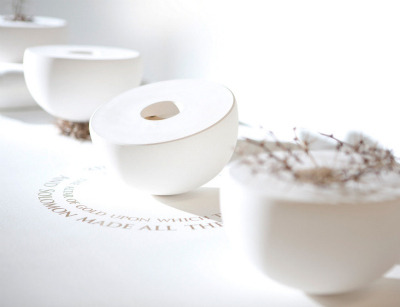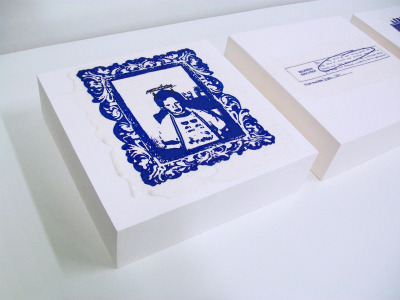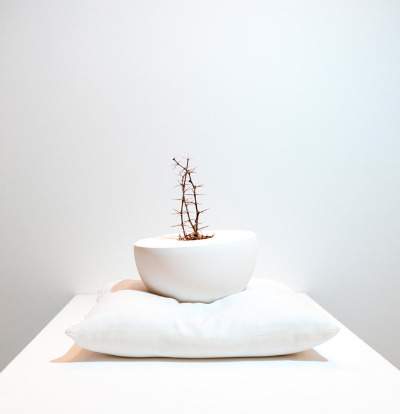
In what techniques do you usually work and what materials do you use?
My practice is multi-disciplinary in nature, from the way I draw, plan installations and think about different concepts. These areas intertwine from the research that informs my work- by rough scribbled drawings on scraps of paper, to precise computer-aided illustrations. I usually need to see my pieces in three dimensions before going any further so after the initial drawing stage, I will construct rough maquettes (usually made from paper, card etc.) to get a sense of scale and presence.
The series Vessels 2010 were first made from turned plaster using a lathe and from that initial investigation I played with scale and proportions before turning to clay to make the finished objects. Vessels 2010 were made in two separate stages. A bowl-like press mould was made, and a large mass of white stoneware was pinched into it so to not create any seams. A top was then made from a slab of clay, and the rather rough pieces were joined and then slow-dried for four days. The pieces were then turned on the wheel to create the desired form and finish. I am interested in clinical forms, which flirt with the idea of mass production, but which disrupt this notion by subtle marks of the maker.
What is your present project, what’s its history and how do you make the pieces?
“If anyone wishes to come after me, let him deny himself, take up his cross and follow me.”- Matthew 16:24
My work explores the role and function of the Vessel within ritual theory and practice. I am currently developing a new body of Vessels which are inspired by the practice of Corporal Mortification used in Orthodox Christian traditions. Corporal Mortification is the practice of inflicting pain on the body as a type of spiritual psychology which uses the ‘body to affect the mind’, punishing man for carnal desires and indulgences, therefore becoming closer to the divine.
This work is still in an early stage of development, and I am beginning to create a series of porcelain paper clay Vessels that challenge the function and ergonomics of the ritual container. I am interested in juxtaposing materials in unusual ways which enable the viewer to question the various connotations that are deep-rooted in society. I manipulate typography, clay, and organic materials to create narratives and conversations across the work.
How did it all start, do you remember your early works? What did you learn from that period?
My career as a ceramic artist began when I enrolled on my BA degree at the University of Ulster, Belfast. I was very fortunate to have fantastic tutors who had a wealth of knowledge and experience who were able to guide me in the right direction. I soon realized that craft was much more than utilitarian objects fit for purpose and began combining skill with concept; “thinking through making.” I have always had a deep interest in religion and spirituality, even though I do not have a belief in a God. I am interested in the theory behind religious practices and their use of ritual and objects and how these rituals can affect the lives of people.

You give great attention to the final work and details, but when you are working on your projects, on what part are you focusing the most?
The finish of my work is very important. Like the parts of a jigsaw, when the different pieces and layers come together they make the work complete. Our relationship with clay is one of ‘mutual respect’; it has its own limitations, but when you get to know the material you can exploit its properties to best suit your desired finish. I enjoy the final stage of making a piece of ceramics- the sanding, sponging and then experimenting with the other materials I am going to include with it. It is a very relaxing and rewarding process.
Where can we find you and your works in the next future?
I am currently in the process of approaching galleries throughout Northern Ireland where I hope to exhibit my new Vessels. As of yet, I have no idea where I will end up- hopefully, I will take my work overseas and reach a wider audience. I am also looking to relocate to a new studio in Belfast.

Give a piece of advice for the young ceramic artists.
Establish an internet presence. This could be from creating your own website (or ask nicely to someone who knows how!) creating a blog or something else which spreads your name and work around. Marketing your work in a professional manner is paramount.
It can be very difficult to make your complete living from being an artist. Be realistic and be prepared to work full-time/part-time somewhere in order to make some money. You can still make your work and spread your name around on a part time basis until you are fortunate enough to earn your full salary from your work.
Shane Porter graduated from the University of Ulster in 2010 with a 1st Class Honours degree in Fine and Applied Art. He is currently based in Belfast and continues to practice in his studio in Dunmurry as part of the Studio 23 collective. Shane will begin a MA Ceramics and Glass degree at the Royal College of Art, London in September 2011.
“My current practice explores the role and function of the vessel within ritual theory and practice. The Vessel contains and protects liquid which during the mass is transubstantiated from wine into the literal blood of Christ. I seek to convey feelings of silence, reflection and reverence by abstracting and subverting religious connotations and metaphors, referencing my uncertainty.” Shane Porter
By Vasi Hirdo.
Published in Ceramics Now Magazine Issue 1.
View Shane Porter’s profile on Ceramics Now.
Visit the artist’s website.



















